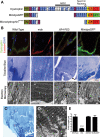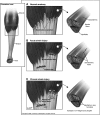Molecular and cellular adaptations to chronic myotendinous strain injury in mdx mice expressing a truncated dystrophin
- PMID: 18799475
- PMCID: PMC2638580
- DOI: 10.1093/hmg/ddn301
Molecular and cellular adaptations to chronic myotendinous strain injury in mdx mice expressing a truncated dystrophin
Abstract
Myotendinous strain injury is the most common injury of human skeletal muscles because the majority of muscle forces are transmitted through this region. Although the immediate response to strain injury is well characterized, the chronic response to myotendinous strain injury is less clear. Here we examined the molecular and cellular adaptations to chronic myotendinous strain injury in mdx mice expressing a microdystrophin transgene (microdystrophin(DeltaR4-R23)). We found that muscles with myotendinous strain injury had an increased expression of utrophin and alpha7-integrin together with the dramatic restructuring of peripheral myofibrils into concentric rings. The sarcolemma of the microdystrophin(DeltaR4-R23)/mdx gastrocnemius muscles was highly protected from experimental lengthening contractions, better than wild-type muscles. We also found a positive correlation between myotendinous strain injury and ringed fibers in the HSA(LR) (human skeletal actin, long repeat) mouse model of myotonic dystrophy. We suggest that changes in protein expression and the formation of rings are adaptations to myotendinous strain injury that help to prevent muscle necrosis and retain the function of necessary muscles during injury, ageing and disease.
Figures






References
-
- Tidball J.G. Force transmission across muscle cell membranes. J. Biomech. 1991;24(Suppl. 1):43–52. - PubMed
-
- Sheard P., Paul A., Duxson M. Intramuscular force transmission. Adv. Exp. Med. Biol. 2002;508:495–499. - PubMed
-
- Garrett W.E., Jr Injuries to the muscle-tendon unit. Instr. Course. Lect. 1988;37:275–282. - PubMed
-
- Garrett W.E., Jr, Nikolaou P.K., Ribbeck B.M., Glisson R.R., Seaber A.V. The effect of muscle architecture on the biomechanical failure properties of skeletal muscle under passive extension. Am. J. Sports. Med. 1988;16:7–12. - PubMed
-
- Taylor D.C., Dalton J.D., Jr, Seaber A.V., Garrett W.E., Jr Experimental muscle strain injury. Early functional and structural deficits and the increased risk for reinjury. Am. J. Sports. Med. 1993;21:190–194. - PubMed
Publication types
MeSH terms
Substances
Grants and funding
LinkOut - more resources
Full Text Sources
Other Literature Sources
Medical
Molecular Biology Databases

